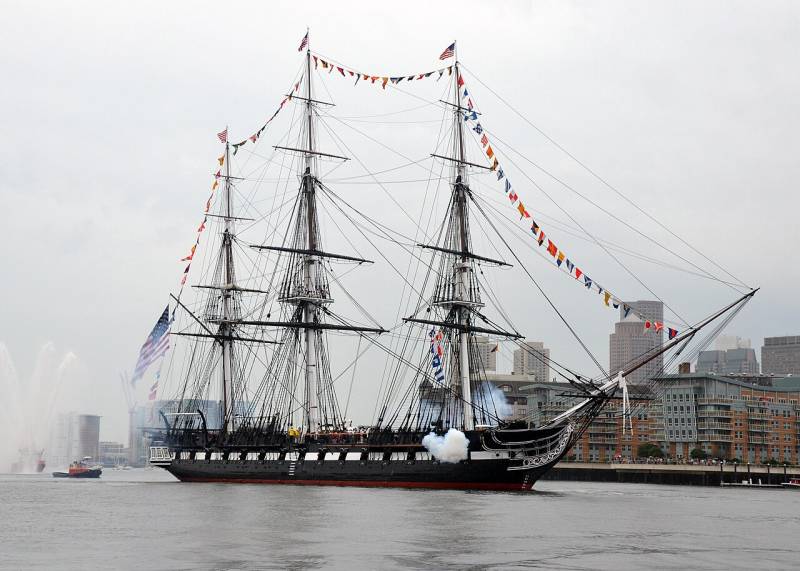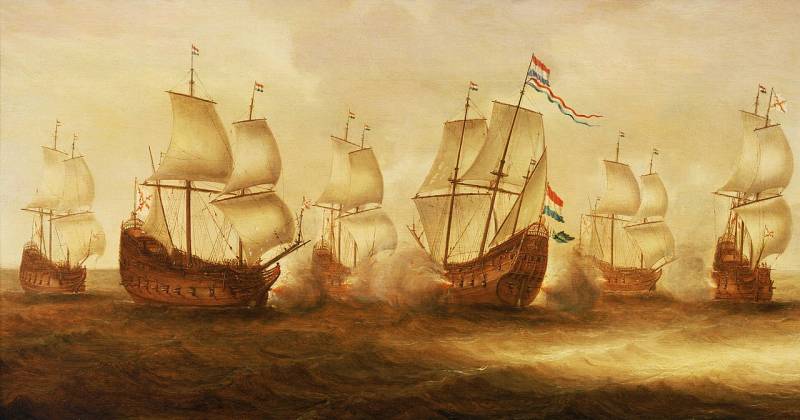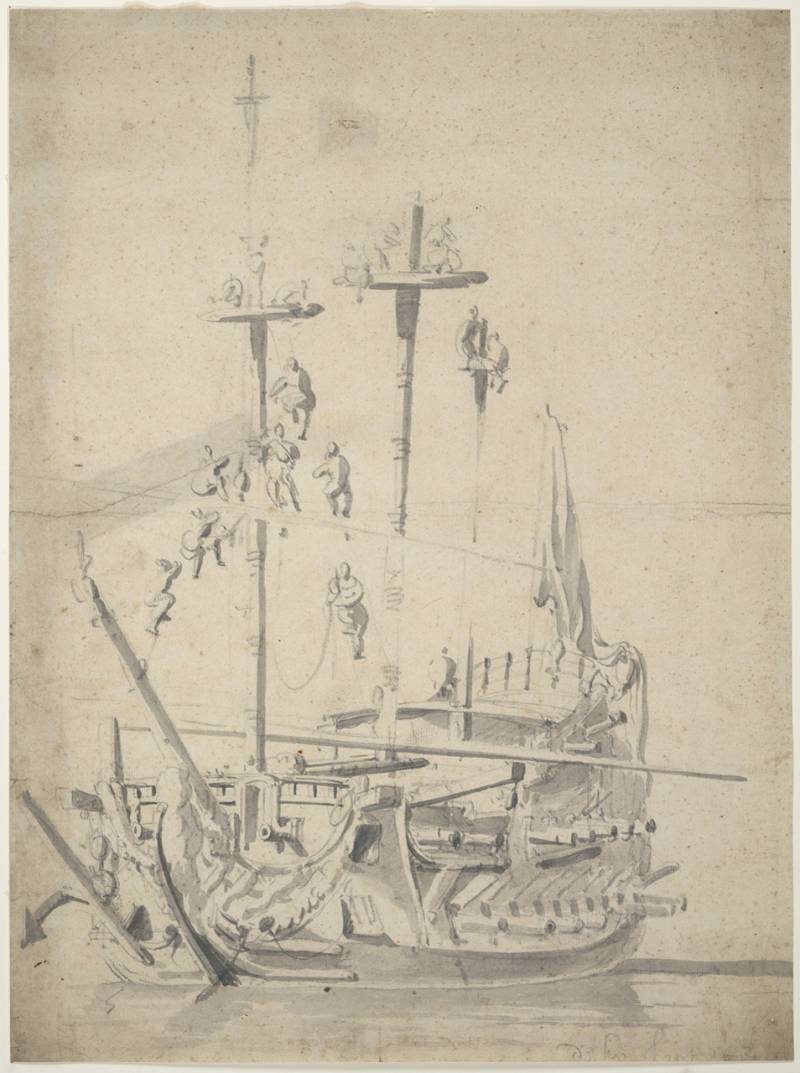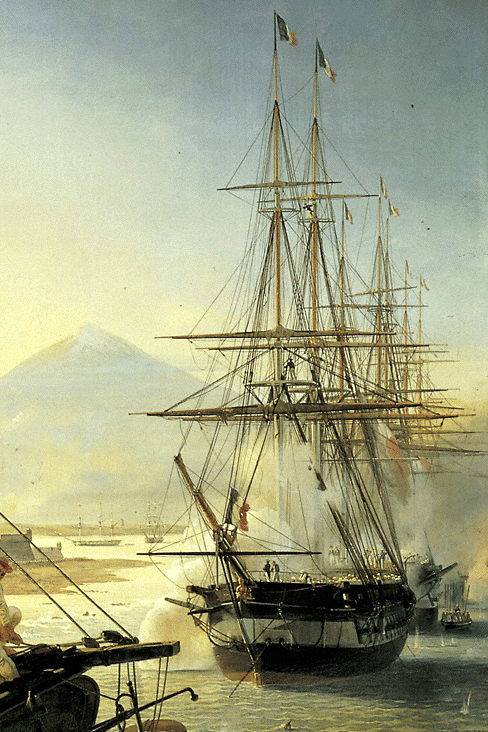Frigates and superfrigates

The frigates themselves began their journey with... galleys. Frigates were once called light galleys intended for raiding, reconnaissance and other missions. But the frigate had two limitations for use - low autonomy and the ability to be used only in good weather.
That is why, between 1606 and 1609, a new type of frigate appeared - already sailing, not rowing, on which Barbary corsairs could even sail to the waters of Northern Europe, and some even to the shores of America.
The beginning of the history of frigates
The frigates became frigates in the 1620s when the Duke of Olivares created the Junta de Armadas (Council of the fleet) and began the construction of a new type of state corsair ships. First 20 frigates, which in German and Dutch began to be called frigates or frigates, were laid down in 1622 at Dunkirk. Initially, these were very light ships from 6 to 9 meters long, with 1–2 guns and one mast, which carried one straight and one oblique sail.
However, soon the Dunkirkers converted Patashas into frigates - sailing and rowing ships that were built in Spain and Portugal. The corsairs removed the oars from them, adapted the oar deck for cannons, increased the length of the masts, now the masts carried three tiers of sails, and the result was a small, but well-armed (from 10 to 18 guns) and high-speed ship, a real raider, a destroyer of trade.

Witte de Witte's battle with the Dunkirkers at Newport in 1640.
The problem was that such a ship most often carried small-caliber guns, and a new iteration of the frigate was created in 1645 by the English shipbuilder Peter Pett, who had both greater speed and powerful weapons - eighteen 9-pounder guns, six 6-pounder guns and two 3-pounders on the quarterdeck. That is, now this ship could easily escape from the one who is stronger than it, and impose and win a battle on any ship weaker than it.
The ship was named Constant Warwick, and in its image and likeness a whole series of frigates were founded in the English fleet, which distinguished themselves in the Anglo-Dutch wars.
And by the 1650s, frigates became a separate type of ship in the English fleet, designed for cruising to enemy coasts (that is, during the war, they did the same thing that corsairs used to do), as well as for attacking retreating and wounded enemy ships in a pitched battle.
But ships of the Constant Warwick type still had poor seaworthiness, and any rough seas forced this type of ship to abandon the use of a closed deck, because it was located too close to the water.

HMS Constant Warwick, 1645.
It was only in 1741 that the French shipbuilder Blaise Ollivier proposed a brilliantly simple solution - to locate the living quarters for the crew under a closed gun deck.
As a result, the artillery deck rose above the water level, the frigates got rid of unnecessary deck superstructures and could now fire even in bad weather. The 26-gun frigate Medee, built by Blas Olivier, is considered the first "true frigate" in stories.
Another innovation was that this ship carried long 8-pounder guns on the main deck, so it was called the 8-pounder.
It is noteworthy that during the War of the Austrian Succession, Medee was captured by the British, and they were so impressed with it that on its basis they created a series of Tiger frigates, which already carried 28 9-pound guns (there were simply no 8-pounders in the English fleet as a class ).
In response, the French commissioned the first 1779-pound frigates in 12, increasing the number of guns to 32. The British responded with 36- and even 38-gun frigates. In 1778, the British installed an “intermediate” caliber on their frigates - 18 pounds, which was once used to arm battleships, and in 1781 the Spaniards and French did the same.
As a result, the parties introduced heavy frigates with almost battleship caliber guns.
Problems of battles in the age of sail
It is probably clear to everyone that warships are not built for parades, but for battle. Unfortunately for shipbuilders and admirals, battle cannot always take place in good weather, and bad weather imposes restrictions not only on maneuverability or seaworthiness, but also on the use of weapons.
Let's look at the armament of battleships of the same English fleet. For example, according to the 1745 regulations, a standard 70-gunner carried twenty-six 32-pounders on the lower deck, twenty-eight 18-pounders on the middle deck, and sixteen 9-pounders on the upper deck and superstructures.

Cross-section of a 74-gun ship.
Maybe the situation changed later?
Actually no. In 1793 alone, three types of 74-guns were developed, one of which was slightly better armed due to the heavier middle deck guns.

Now let’s assume that the battle begins in inclement or stormy weather, and besides, the battleships attack from a windward position, that is, the ship is tilted on board, facing the enemy. In this case, the heavy lower deck guns will be taken out of the fight, and, in fact, the powerful ship will be left with 18- and 9-pounders against... frigate 18- and 9-pounders. That is, paradoxically, the armament of a battleship and a frigate will be equal.
But this is nothing, because in 1794 the French began building 50-gun superfrigates with 24-pounder guns on the front deck, the first two - Forte and Égyptienne - each had thirty 24-pounder and twenty 12-pounder guns. That is, it turned out that now the frigates were armed like battleships, and in bad weather - even better than battleships, because the guns on the lower decks were difficult to use in bad weather.
The problem with these frigates was that there was too much load on the keel, resulting in a “banana effect”, the keel at the bow and stern arched, and as a result, the horizontal connections of the hull weakened and collapsed.
Around the same time, Joshua Humphreys and Joshua Humphreys began construction of 44-gun, 24-pounder frigates for the US Navy in the New World. In 1797, the 44-gun frigates United States, Constitution and President were launched. These ships carried thirty 24-pounder guns on the front deck, and initially 12- and 9-pounder guns on the upper deck and superstructures, but these were replaced by 1800- and 32-pounder carronades in 42.
Humphreys, using diagonal bracing, was able to strengthen the keel, and as a result, these ships were spared the French "banana effect". During the war of 1812–1815. American superfrigates were an unpleasant surprise for the British, especially since the thickness of the side in the area of the main artillery deck was that of a battleship, 63 cm, and increasing the length of the masts and adding a fifth tier of sails made it possible for the superfrigates to reach speeds of up to 14 knots.
As a result of frigate duels, the Americans were able to defeat and capture the following English frigates: 38-gun 18-pounder Java, 38-gun 18-pounder Guerriere and 38-gun 18-pounder Macedonian.
Thus, superfrigates have shown that they are head and shoulders superior to heavy frigates.

USS Constitution.
An editorial published in the Naval chronicle said:
They tried to blame everything on French construction (Java and Guerriere were French prizes), emphasizing the fact that the French made 7-inch (18 cm) hull planking, while the British, since Anson's time, laid foot (20 cm) hull planking in the velhout area . But what about Macedonian, which was a purely British frigate?
British admirals never understood that American superfrigates are still small battleships, not big frigates. And that in order to successfully fight them, you must either surpass the Americans in the weight of the salvo, or in speed, or, even better, in both. Like must be beaten with like. Against these single-deck battleships, battleships are also needed.
Here it should be clearly understood that American victories are not the victory of the “fast frigate” concept, but the triumph of the “fast battleship” concept.
However, after the loss of the Macedonian, the British decided that like should be treated with like, and simply cut off the upper decks of the three 74-gun Goliath, Majestic and Saturn, resulting in 58-gun super-heavy frigates with 32-pounder guns on the lower deck.
It is noteworthy that this decision gave approximately the same “armor” as that of the Americans, and since the 74-guns were shorter than superfrigates, the longitudinal connections on them were stronger.
Transition to a single caliber
After the Napoleonic Wars, the French seriously thought about rearmament of their fleet and laid down an experimental series of 50-gun 24-pounder frigates, which entered service from 1820 to 1825. It turned out that these frigates in inclement weather were stronger than the traditional 74-gun ships, which carried only 18-pounders on the middle deck.
However, soon the first reviews came about the new frigates, which were discouraging - they turned out to be poorly maneuverable, the speed did not exceed 10 knots.
In order to somehow strengthen the fleet, the French decided to follow the British path and simply cut down one of their 74-gun Romulus to a 58-gun, and suddenly got an excellent result. The cut-down 58-gun frigate, named Guerriere, had twenty-eight 36-pounder guns on the front deck and thirty 18-pounder guns and carronades on the superstructure.
In 1822, Baron Jeanne-Marguerite Toupigne, who then headed the Commission de Paris (Paris Commission), proposed switching to a new caliber of frigates and battleships - 30-pounder. Since the Americans have frigates with 24-pound cannons, and the British with 32-pounders, the French 30-pound caliber will be superior to American ships and will be approximately equal to the English (the French pound is heavier than the British).

French 52-gun 30-pound frigate Gloire, 1837.
This is how the idea of uniform weapons on all artillery decks arose. Now, according to the plan, the frigates were to carry twenty-six to twenty-eight 30-pound long guns on the front deck, and eighteen to twenty-two 30-pound carronades on the upper deck. The result was a kind of “all big gun” ship of the first quarter of the XNUMXth century.
The advantages of this decision were obvious - now all the guns had the same caliber, so the cannonballs and shells could be used for any gun.
Later, it was proposed to extend this system to battleships.
According to the new system, the new three-deck ships carried 120 guns, the two-deck ships consisted of 82 and 90 guns, all ships carried 30-pound long guns on the main deck, 30-pound short guns on the middeck and 30-pound carronades on the superstructures. Three classes of frigates remained - 30-pounder, 24-pounder and 18-pounder, but gradually they all had to switch to new weapons - 30-pounder guns of the same type.
The Toupigné system was adopted as a standard on March 10, 1824, and lasted until the end of the age of sail.
References:
1. W. James “Naval history of Great Britain”, vol. I–IV – London, 1837.
2. Drolet, Marc “The North American Squadron of the Royal Navy, 1807–1815” - McGill University, 2003.
3. Patrick Villiers “Les corsaires du littoral: Dunkerque, Calais, Boulogne, de Philippe II à Louis XIV (1568–1713)” – PU Septentrion, 2000.
4. Howard L. Chapelle, “History of the American Sailing Navy” - New York, 1949.
5. Robert Gardiner “The Sailing Frigate. A History in ship models” – Seaforth Publishing, 2012.
6. DK Brown “Before the Ironclad” – Seaforth Publishing, 2015.
7. Brian Lavery “The Arming and Fitting of English Ships of War, 1600–1815” - Conway, 1998.
Information